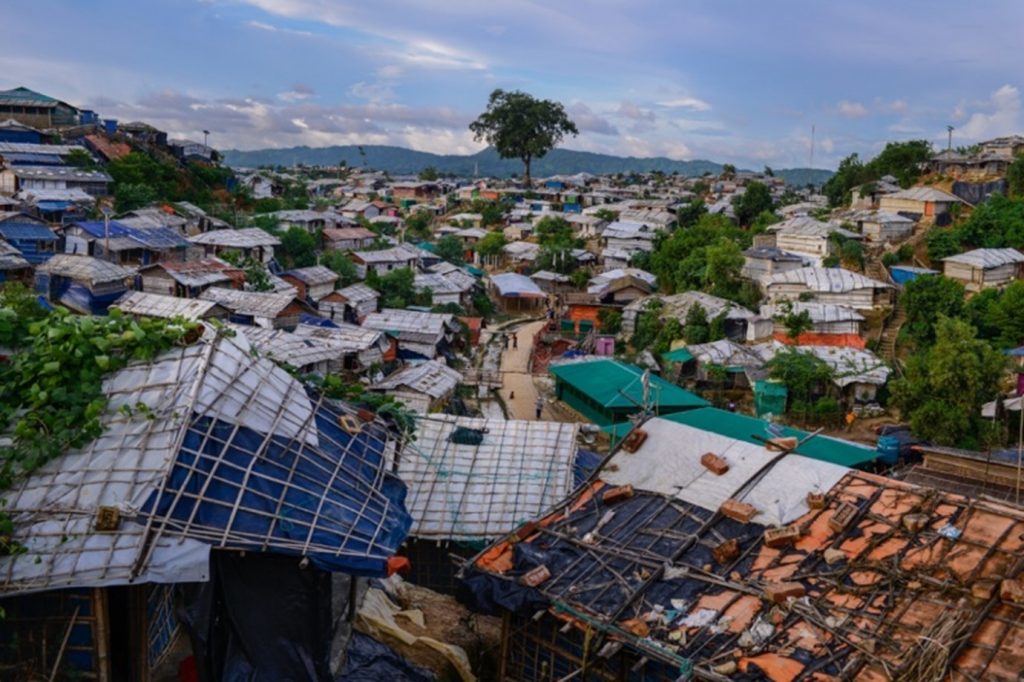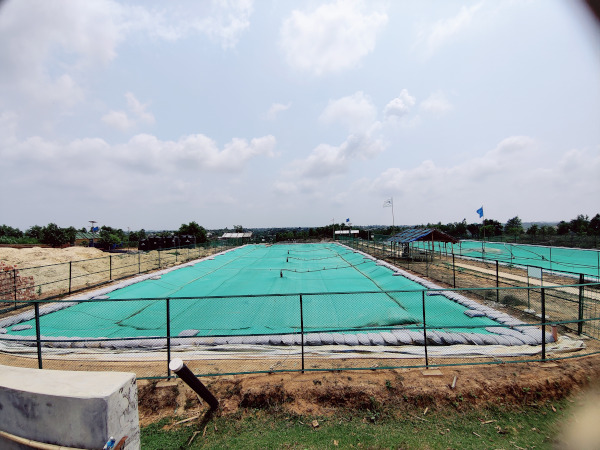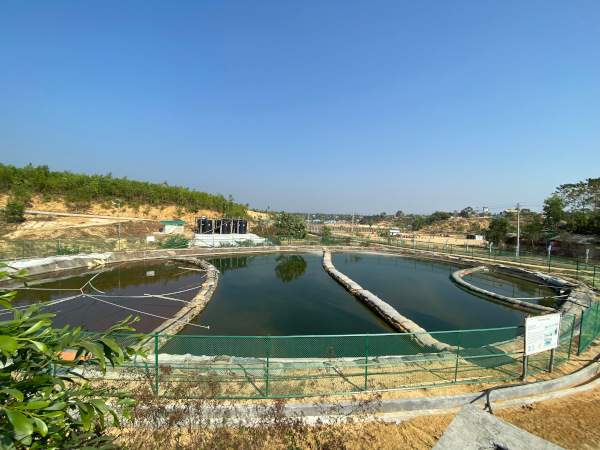In a blog for World Toilet Day, Oxfam’s Safwatul Haque Niloy looks at a pioneering project with engineering firm Arup that is pinpointing the best ways to deal with the huge challenge posed by waste from thousands of latrines

In 2017, around 700,000 Rohingya people fled Myanmar and arrived in the Cox’s Bazar district in Bangladesh, leading to the formation of a vast refugee camp. One of the biggest tasks for local agencies and international NGOs was to provide enough toilets as fast as possible. Thousands of shallow pit latrines were created, creating a huge challenge: how could the camp handle the massive amounts of waste from these toilets, which posed a threat to people’s health if not managed properly?
To add to the challenge, the camp – in fact a cluster of smaller camps – is located on steep, hilly terrain which is prone to landslides and monsoon flooding. That puts huge stress on the sanitation systems that are vital to prevent the spread of disease.
The technical term for managing the toilet waste is “faecal sludge management” (FSM), with faecal sludge referring not just to human excreta, but also anything else that may go into the toilet such as flushwater, cleaning materials, period products, bathing water etc.
When camp settings cannot deal with the sheer quantity of waste via good FSM, it often ends up polluting local rivers, lakes, seas, and surrounding land. At Cox’s Bazar, with up to 25 people using one pit latrine, each would be filled up in as little as three weeks. People forced to live near waste that is not removed face real disease risks, including diarrhoea and skin diseases. The pressure on the camp’s FSM systems could be seen in 2018, when there were more than 200,000 cases of acute diarrhoea reported in the Cox’s Bazar camps, according to the WHO and the local Ministry of Health and Family Welfare.
New thinking – and a first for refugee camps
Oxfam and the UNHCR (United Nations Refugee Agency) met to consider a solution to the huge FSM challenge. The decision? Cox’s Bazar would need the world’s first large-scale biological treatment plant for a refugee camp.
Funded by the UNHCR (the United Nations Refugee Agency), Oxfam contracted BORDA (Bremen Overseas Research and Development Association) who are specialists in sanitation systems to work with us. Together, we commissioned a large faecal sludge treatment plant (FSTP) in 2018, with the capacity to manage 120m3/day, serving a population of 150,000 and receiving faecal sludge from five to seven camps. In the initial plant, the process uses lagoons that not only separate liquid and solid by gravity, and biodegrade the organic constituents for further treatment, but also produce biogas as source of clean, renewable energy (see picture, below).
A second centralised treatment plant with a capacity of 180m3/day was then built in collaboration with the Medecins Sans Frontieres (MSF) NGO and the UNHCR. This uses a natural process to treat the waste using bacteria and plants.
Construction of a third treatment plant with a capacity of 120m3/day will start soon. Being able to treat large volumes of faecal waste in a centralised FSTP (faecal sludge treatment plant), rather than having to transport it elsewhere, is a big step forward in managing such waste safely and sustainably in emergencies.
Beyond the construction of the plants, a ground-breaking part of this work has been Oxfam’s partnership with engineering firm Arup, to evaluate the best ways to do faecal sludge management.

The lagoons separate liquid and solid waste by gravity, and biodegrade the organic constituents for further treatment, producing biogas as source of clean, renewable energy (picture: Oxfam)
How can we build better, more sustainable faecal sludge systems?

In 2018, Oxfam began working with engineering firm Arup to conduct a technical assessment of the varying FSM systems being used in Cox’s Bazaar (including lime stabilisation sites, constructed wetlands, geotubes, aeration and anaerobic baffled reactors).
An initial study concluded that lime treatment (a method of applying chemicals to treat faecal sludge) was the most appropriate in the immediate phase of the emergency response but, as this was not deemed an appropriate long-term solution, it was decided to evaluate the various methods of managing FSM at faecal sludge treatment plants over a longer time period.
This second evaluation with Arup in 2022 reviews the entire faecal sludge chain (see diagram above), from the type of toilet to the method of desludging and the transportation of the sludge to the final treatment site. This provided a much clearer picture of what systems are most sustainable in terms of ease of operation, maintenance, and cost in the long-term.
Arup, Oxfam and a core team of WASH (water, sanitation and hygiene) representatives in Cox’s Bazaar, identified a wider stakeholder group operating FSM in the camps to include in the study and provide evidence/data for analysis.
The study posed questions including:
- Does each part of the chain have capacity to manage the sludge generated? What are the bottlenecks and inefficiencies? How can these be addressed?
- Which type of faecal sludge treatment plants are performing best?
- Which mode of faecal sludge transfer/transport is most cost-effective and resilient?
The importance of safe transport of faecal sludge through pipes
The report found that in total there are around 50,000 onsite latrine units in the Rohingya camps and eight main types of containment for the faecal sludge. Most widespread type is the direct pit (essentially a hole in the ground, and present in 23 different camps), followed by the septic tank. How often the latrines need clearing or “desludging” is heavily influenced by the weather. The rainy season can increase the volume of sludge in pit latrines by up to 26%, yet the frequency of desludging can actually drop in the rainy season due to challenges with transportation and capacity.
The evaluation found transporting the sludge (see diagram above) is pivotal to the success of the process: transporting the faecal sludge can be a bottleneck for the whole FSM chain. And a good system will avoid any manual sludge carrying for efficiency and to reduce public health risks. Oxfam’s system in the camps relies on underground sludge transfer pipe networks connected with treatment plants.

The report concluded that such permanent pipe networks can transport more sludge and are more cost-efficient in the long term. It also said our centralised treatment plants were operating well and have a low cost when considering the volume of sludge treated.
Of course, there is more work to be done, such as looking at the potential for recycling solid products from the process, but the study has given a clear steer for management of toilet systems in similar emergencies around the globe.
Andy Bastable, Head of Water and Sanitation at Oxfam, says: “Doing this study with Arup has not only added a rigorous professional approach and an outstanding, wonderfully presented report but has increased the knowledge of all the Oxfam staff involved on faecal sludge treatment enabling us to use some of the best practice from Cox’s Bazar in other emergencies across the world.”
Anna Grieve, Senior Water Engineer at Arup, says: “It has been a great experience working on this project. The Oxfam Bangladesh team and other stakeholders were incredibly open with sharing information and knowledge, which allowed us to make a robust assessment of the full FSM chains in the camps. I hope the learning from this project will inform best practice FSM in future.”

Find out more about Oxfam’s work on faecal sludge management and read the full Arup technical report here. This blog is published to mark World Toilet Day on November 19, which aims to highlight the global sanitation crisis.
We thank all the donors, government authorities, WASH agencies and sanitation workers who are working hard to ensure safe sanitation for the Rohingya communities in Cox’s Bazar.